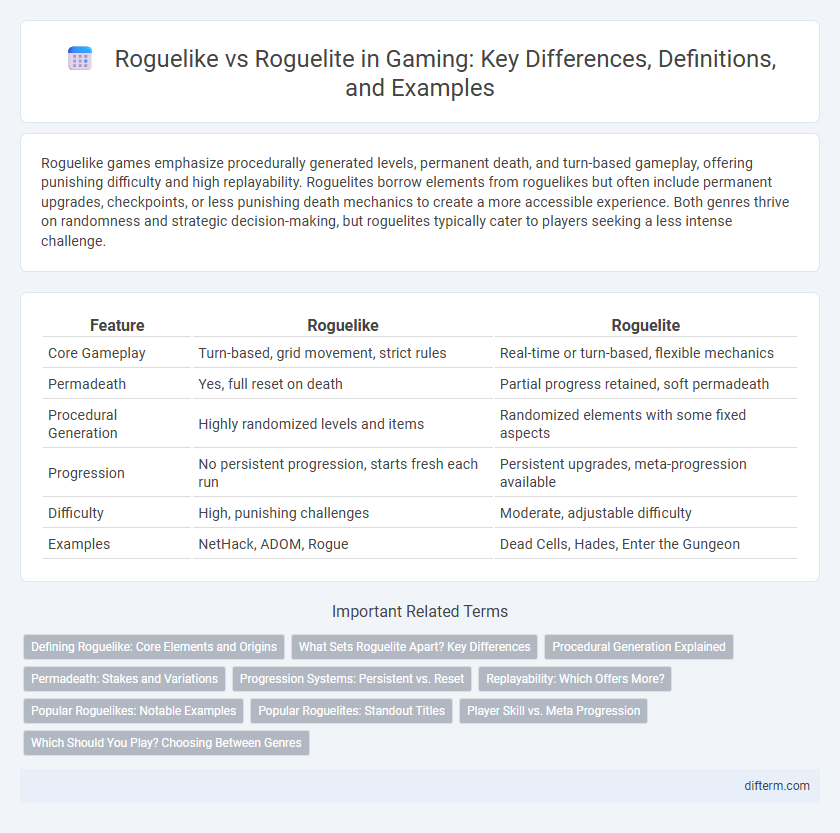Roguelike games emphasize procedurally generated levels, permanent death, and turn-based gameplay, offering punishing difficulty and high replayability. Roguelites borrow elements from roguelikes but often include permanent upgrades, checkpoints, or less punishing death mechanics to create a more accessible experience. Both genres thrive on randomness and strategic decision-making, but roguelites typically cater to players seeking a less intense challenge.
Table of Comparison
| Feature | Roguelike | Roguelite |
|---|---|---|
| Core Gameplay | Turn-based, grid movement, strict rules | Real-time or turn-based, flexible mechanics |
| Permadeath | Yes, full reset on death | Partial progress retained, soft permadeath |
| Procedural Generation | Highly randomized levels and items | Randomized elements with some fixed aspects |
| Progression | No persistent progression, starts fresh each run | Persistent upgrades, meta-progression available |
| Difficulty | High, punishing challenges | Moderate, adjustable difficulty |
| Examples | NetHack, ADOM, Rogue | Dead Cells, Hades, Enter the Gungeon |
Defining Roguelike: Core Elements and Origins
Roguelike games are defined by their procedural generation, turn-based gameplay, permadeath, and grid-based movement, deriving inspiration from the 1980 game Rogue. Core elements include randomized dungeon layouts, high difficulty, and permanent consequences for player actions, fostering strategic planning and replayability. Originating from early PC gaming, roguelikes emphasize exploration, resource management, and tactical combat in a challenging, unpredictable environment.
What Sets Roguelite Apart? Key Differences
Roguelite games differentiate themselves from roguelikes through their more accessible gameplay, featuring permanent progression elements such as character upgrades or unlockable content that persist across runs. Unlike traditional roguelikes, which emphasize strict procedural generation and permadeath with minimal carryover, roguelites blend these mechanics with elements from other genres to reduce frustration and increase player retention. The key difference lies in roguelites' balance between challenge and progression, enabling a more forgiving experience while maintaining procedural unpredictability.
Procedural Generation Explained
Procedural generation in roguelike games creates entire levels, enemies, and items through algorithms, ensuring a unique gaming experience with high replayability. Roguelites incorporate procedural elements but often blend them with fixed structures or persistent character upgrades, balancing randomness with progression. This approach allows players to experience varied challenges while retaining some continuity across playthroughs.
Permadeath: Stakes and Variations
Permadeath in roguelikes enforces a strict consequence where player progress is entirely lost upon death, emphasizing high stakes and strategic gameplay. Roguelites modify this by incorporating partial persistence, allowing elements like unlocked abilities or currency to carry over between runs, reducing frustration and encouraging experimentation. These variations between roguelike and roguelite permadeath systems fundamentally shape player experience and replayability.
Progression Systems: Persistent vs. Reset
Roguelike games feature progression systems with full resets upon death, requiring players to start from scratch and emphasizing skill mastery and exploration. Roguelite games incorporate persistent progression elements, such as unlockable upgrades or currency that carry over between runs, enabling gradual advancement and customization. This fundamental difference in progression systems shapes player experience by balancing challenge and long-term growth.
Replayability: Which Offers More?
Roguelike games typically offer higher replayability due to their procedural generation, permadeath mechanics, and challenging gameplay that ensure each run feels unique and unpredictable. Roguelite games, while incorporating some roguelike elements, often feature persistent upgrades and progression systems that balance difficulty with a sense of long-term achievement. Players seeking endless variety and strategic adaptation may prefer roguelikes, whereas those valuing gradual progression might favor roguelites for replay value.
Popular Roguelikes: Notable Examples
Popular roguelikes such as "NetHack," "ADOM," and "Dungeon Crawl Stone Soup" emphasize procedurally generated levels, permadeath, and turn-based gameplay, creating highly challenging experiences. In contrast, notable roguelites like "Dead Cells," "Hades," and "Slay the Spire" blend roguelike mechanics with progression systems, allowing players to retain some upgrades after death. These distinctions highlight the evolving appeal and design philosophies within the roguelike and roguelite gaming genres.
Popular Roguelites: Standout Titles
Popular roguelites like Hades, Dead Cells, and Slay the Spire have redefined procedural gameplay by blending persistent progression with randomized elements, offering accessible yet challenging experiences. These standout titles emphasize character upgrades, evolving skill trees, and strategic depth, distinguishing them from traditional roguelikes by incorporating more forgiving mechanics. Their success illustrates the genre's adaptability, appealing to both hardcore players and newcomers through dynamic replayability and narrative integration.
Player Skill vs. Meta Progression
Roguelike games emphasize player skill through procedural generation and permadeath, requiring mastery of mechanics and strategic adaptability in each run. Roguelite titles incorporate meta progression elements, allowing players to unlock permanent upgrades that enhance future attempts and reduce reliance solely on immediate skill. This balance between skill and progression shapes distinct gameplay experiences, catering to different preferences for challenge and player development.
Which Should You Play? Choosing Between Genres
Roguelike games offer procedurally generated levels, permadeath, and turn-based mechanics for a challenging, strategic experience that rewards patience and skill. Roguelites feature similar elements but with persistent upgrades and more forgiving gameplay, suitable for players seeking progression without starting over each time. Choose roguelikes for hardcore difficulty and unpredictability, or roguelites if you prefer a blend of difficulty with continuous character growth.
roguelike vs roguelite Infographic

 difterm.com
difterm.com